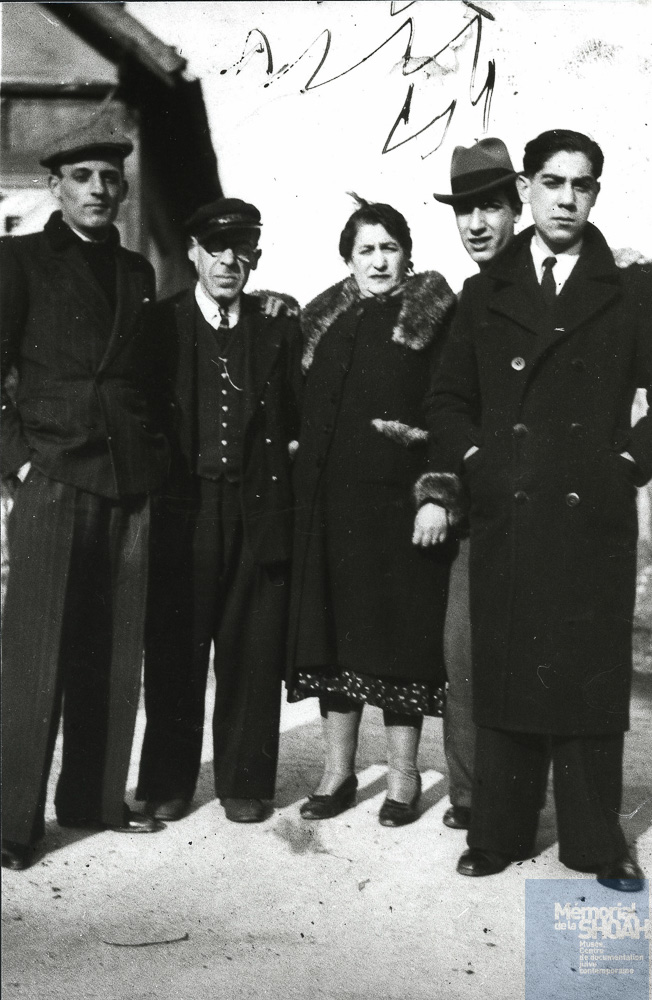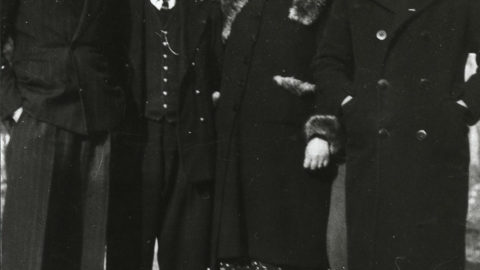Biography of Charles MOHA
The Jewish presence in North Africa is ancient. While the first communities appeared in the 6th century B.C., they only truly took root in the region toward the end of the 1st century A.D., after the destruction of the temple in Jerusalem and the massive exile of the Jewish population from the Holy Land. In the 1st century the North African Jews were generally Latin-speaking descendants of families that had taken part in the revolt against the Roman Empire. Some also descended from sub-Saharan Berbers converted or assimilated to Judaism. This Israelite community, more or less tolerated according to the times and the reigning dynasties, was to be reinforced by the arrival of numerous Andalusian Jews fleeing the Christian persecutions in Spain and finding refuge in the Maghreb after the Reconquista in the Middle Ages. The ethnic composition of the Algerian Jewish communities would subsequently remain more or less unchanged. Spain’s attempt to dominate the Maghreb was then stymied by the Ottomans. North African Jews took the status of dhimmis (granted to Jews and Christians by Islamic law). They enjoyed military protection, juridical autonomy, and a certain degree of religious freedom, but were also subjected to certain constraints: They were forbidden to build any building higher than Muslim structures, could not bear arms, were excluded from certain professions, and higher taxes were levied on them in times of crisis. Oppression reached a high point with the massacre of the Jews of Algiers following the failed revolution against the Dey in 1805 and was to last until the beginning of French colonization in 1830. After the conquest of Algeria by France a royal edict on November 9, 1845 decreed the establishment of Israelite consistories (administrations assigned the task of organizing the Jewish cult) and 26,000 Jews were placed under the authority of these consistories.
It was in this particular context, but also within the long history of the Algerian Jews, that Eliaou MOHA was born in 1810. The MOHA family was thus living in Algiers when Algeria became a French colony. Eliaou was married in 1844 by the Chief Rabbi of Algiers, and he had a son, Abraham MOHA, born in 1854. The MOHA family benefited from the Crémieux Decree of October 24, 1870, which granted French citizenship to the Algerian Jews. On March 13, 1877, Abraham MOHA, who worked as a cobbler, married Semah Mesaltob AMAR, also of Algiers (Abraham’s grave lies in the Israelite sector n°22 of the Bologhine Cemetery in Algiers at the food of the hill overlooked by Notre-Dame d’Afrique). Five children were born of this marriage; among them Charles MOHA was born on May 29, 1890 at 19 rue Marengo in the Algiers Kasbah. There is little information on Charles’ childhood, but it is known that he reached the third level of general education, i.e. somewhat beyond the basic elementary level of reading, writing and arithmetic. He was obviously oriented toward manual work, since at his enrollment for military conscription in 1910 he was working as a house painter. Charles no doubt spent his childhood in the Judeo-Arab area of the Kasbah, and more precisely, given his address, in the quarter of the lower Kasbah, where the descendants of the Spanish Jews lived. He grew up beside Arab and French children during an era of great architectural transformation in Algiers, especially in and around his neighborhood.
After the start of the First World War thousands of Algerian soldiers, both Jewish and Muslim, were sent to fight at the front. Charles Moha left Algeria with the African Army and served in the automobile supply center in Orléans in 1915-1916. In 1917 he returned to Algeria and continued to participate in the war effort as a caster in the Lescurat et Compagnie factory, a mechanical construction enterprise situated on the port of Algiers. Meanwhile, on July 22, 1915, he married Zina DJIAN (also spelled Zéna, Zina, Lina, Lucie, Lucia, according to different registers) in Algiers. Demobilized in 1919, he took up residence at n° 1 rue Rosetti (currently rue Ali Bestani) in the Bab-el-Oued quarter. Thus, Charles Moha lived in the popular neighborhoods of the Kasbah and Bab-el-Oued in colonial Algiers in the early twentieth century. We lose track of him right after the war, but as he was recorded in the census of the Seine area we know that in 1926-1927 Charles had left Algiers for the Paris region, which is elsewhere confirmed by his military record, which indicates his residence in 1929 as 13 rue Abel in the 13th district of Paris. Charles and his wife Lina left Algiers with one of their twin daughters, Berthe born on 24 April, 1920, the other one being born dead, their son Marcel, born on November 10, 1921, and their daughter Félicie, born April 5, 1925, and the family grew on the other side of the Mediterranean with the birth of Roger in the 4th district of Paris on April 13, 1927. During the second half of the 1920’s Charles Moha and his family thus lived in Paris, but the reasons for their settlement in mainland France are unknown.
In 1940 the Vichy regime decreed the abolition of the Crémieux Decree and implemented a series of anti-Semitic measures. A great many Jews tried to cover their citizenship — a status worse than that of the indigenous Muslims — by settling in mainland France, where they tried to pass themselves off as Arabs. There are many stories of Jews taking advantage of their name’s ambiguity, sometimes exactly like that of a Muslim Arab, to escape repression. Some also crossed the Mediterranean in the other direction to escape the persecution in full sway in France. The article “North African Jews in the Pletzl? A largely unknown presence and forgotten hardships (1920-1945) “, by Jean Laloum, contains precious information on the movements of the Moha family; it is revealed that Marcel returned to an aunt’s in Algiers but, unable to be housed, he was apparently forced to come back to Paris:
« Esther Arous enjoined her son Prosper, after the first arrests, to take refuge with an aunt in Algiers. Finally, his cousin Marcel Moha and his girlfriend were also on the trip but, as the aunt was incapable of lodging them all, they quickly returned to France. The two cousins were to be deported.”
This Esther Arous was born DJIAN on January 12, 1889 in Algiers. She was Charles Moha’s sister-in-law. Deported on September 28 in convoy 38, she was murdered on October 3, 1942 at Auschwitz in Poland. Unhappily, like most of the Algerian Jews in France, the Mohas, still living at 13 rue Abel, were also rounded up and deported to Auschwitz on July 31, 1944 in the last convoy – convoy 77– to leave Drancy. Thus died Charles, Zina, Marcel, Félicie, and Roger MOHA on August 5, 1944, hardly three weeks before the liberation of Paris by the Allies: a whole Jewish family wiped out in what remains the greatest crime against humanity. Félicie Moha, returned from the hell of Auschwitz, maried in 1946, and gave birth to Gilles in 1947 and to Ghislaine in 1957. Gilles and Ghislaine have two cousins, Michèle Monet, daughter to Berthe Moha and Jocelyne Callot, daughter to Marcel Moha, who will die anaware of it.


 Français
Français Polski
Polski












Bonjour, je suis Séverine Bouchet l’arrière petite fille de Charles et Zina Moha et la petite fille de Berthe Moha née le 24/04/1920, fille ainée de Charles et ZIna, “l’une de leurs deux jumelles”, celle qui a survécu à la naissance. Je viens vers vous après avoir pris connaissance de votre article et vous remercie pour votre travail qui permet de ne pas oublier ce drame innommable que fut la SHOAH.
Par ailleurs, je souhaite que le prénom de ma grand-mère soit mentionné, comme ceux des autres enfants de mes arrière-grands-parents. Il est vrai qu’elle n’a pas été déportée mais croyez-moi la souffrance d’avoir perdu toute sa famille de façon si violente et dans les conditions atroces que nous connaissons tous aujourd’hui, l’a accompagnée toute sa vie durant ; et, cette souffrance, nous petits-enfants ou arrière-petits-enfants de déportés nous la portons également en nous à tout jamais
En outre, c’est elle qui a accueilli sa petite sœur, Félicie Moha, à la sortie des camps et qui s’en est occupée comme une mère et l’a aimée et choyée de tout son cœur et de toute son âme.
Voilà pourquoi, je fais cette requête plus que légitime afin que soit mentionné le prénom de ma grand-mère maternelle au côté de ses frères et sœurs, Félicie, Marcel et Roger.
De même, à la fin de votre article, vous mentionnez les prénoms et noms des enfants de Félicie Moha . Il s’agit de Gilles et Ghislaine Secaz, respectivement le cousin germain et la cousine germaine de ma mère, Michèle Monet, fille de Berthe Moha mais également les cousins germains de la fille de Marcel Moha, Jocelyne Callot, qu’hélas, il n’aura jamais eu la chance de connaître.
Là aussi, il est plus que légitime qu’apparaissent le prénom et nom de ma mère, Michèle Monet, fille de Berthe Moha ainsi que celui de Jocelyne Callot, fille de Marcel Moha au même titre qu’apparaissent les prénoms et noms des enfants de Félicie Moha, Gilles et Ghislaine Secaz, tous les 4, petits-enfants de Charles et Zina Moha.
Je vous remercie de l’attention que vous porterez à ma requête et me tiens à votre entière disposition pour tous renseignements complémentaires.
En espérant avoir un retour de votre part.
Très cordialement,
Séverine Bouchet